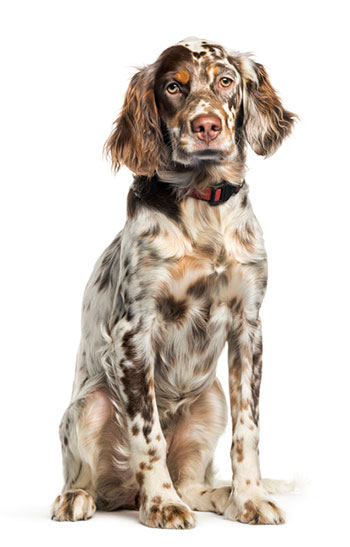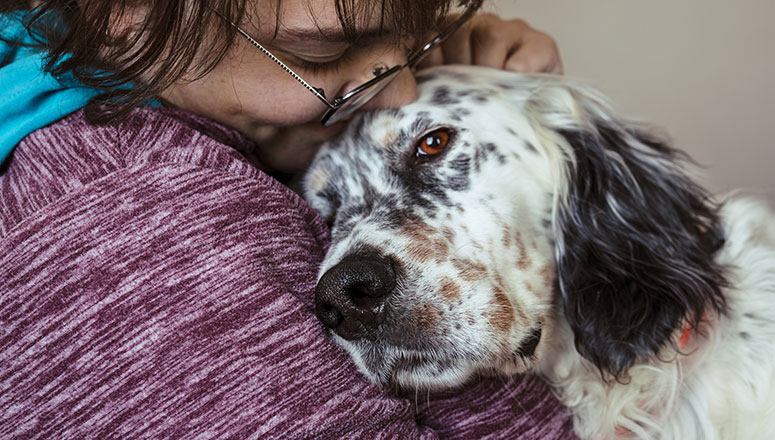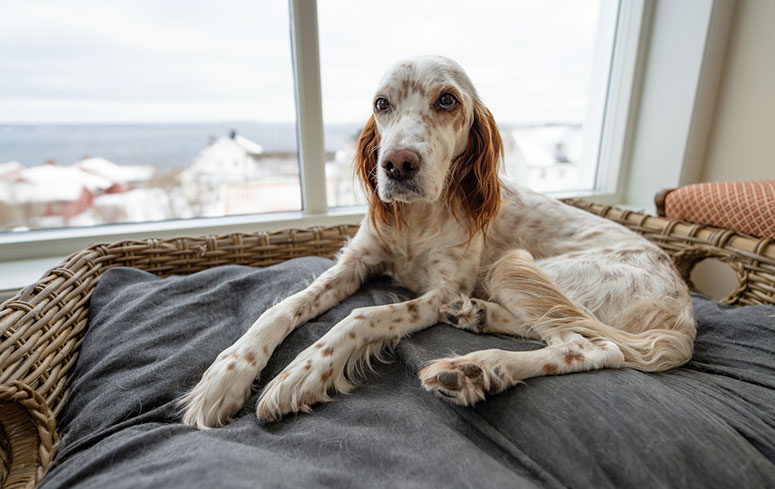Table of Contents
Introduction to English Setters
The English setter is a friendly and mellow sporting group dog breed. This medium-sized dog is one of four types of British setters recognized by the American Kennel Club. Today, these versatile dogs are primarily known for being charming and elegant household companions. But in the past (and even now), they were used as hunting dogs that excelled at locating prey on expeditions in the British countryside.
In this Healthy Paws dog breed guide, you will learn all about the English setter, including important details regarding the dog’s characteristics, health needs, and care requirements.
Size of English Setters
A fully grown male English setter is 25 to 27 inches tall and weighs 65 to 80 pounds. Females are 23 to 25 inches tall and 45 to 55 pounds. These dogs are typically done growing by 18 months.
Here’s how big you can expect your English setter to get as the dog grows from puppyhood to adulthood:
| Average Weight Chart | 6 months | 12 months | 18 months |
| Male English setters | 42-60 lbs. | 50-75 lbs. | 65-80 lbs. |
| Female English setters | 30-45 lbs. | 35-52 lbs. | 45-55 lbs. |
Characteristics of English Setters
English setters are moderately adaptable dogs that can tolerate warm and cool weather. They are very friendly dogs that love family members, kids, other dogs, and even strangers. These dogs are ideal for active families and hunting enthusiasts. Because of their easygoing nature and sweet demeanor, they are a good match for first-time pet parents.
As you get to know an English setter’s personality, here’s what you can expect based on the breed characteristics.
| Breed Characteristic | Level (High, Medium, Low) |
| Affectionate with People | High |
| Good with Kids | High |
| Good with Pets | High |
| Need for Exercise | High |
| Energy Level | Medium |
| Intelligence Level | High |
| Able to Be Trained | High |
| Amount of Barking | Medium |
| Amount of Shedding | Medium |
History of English Setters
The history of the English setter goes back over 400 years to when the dogs were bred in the English countryside. Breeders crossed old spaniel and pointer breeds to develop the English setter, which excelled at crouching quietly (“setting”) while locating game birds. Edward Laverack is credited with developing the breed from dogs named “Old Moll” and “Ponto” that were part of a 35-year-old line of English setters.
The breed became popular in Britain and later in America for hunting purposes. The American Kennel Club recognized the breed in 1878 after the dogs arrived in the U.S. in the late 1800s. English setters are successful show dogs and hunters today, but most are beloved family companions who join their humans in many of life’s adventures.
English Setter Standard Information
The general appearance of an English setter is elegant, symmetrical, graceful, and strong. Male and female dogs have distinctly masculine and feminine characteristics. The American Kennel Club’s official breed standard describes other features by which these dogs are judged at shows.
Here is an overview of the breed standard information for English setters:
Head:
- Long and lean head
- Oval skull when viewed from the top
- Long and square muzzle
- Dark brown eyes
- Well-set-back ears that are low and even or below eye level
Neck, Topline, Body:
- Long, muscular, and lean neck
- Topline appears level or slopes slightly downward
- Deep chest but not wide or round to interfere with foreleg action
- Tail tapers to a fine point and is feathered, straight, and silky
Forequarters:
- Shoulder blade is well laid back
- Shoulders are fairly close together at the tips
- Forelegs are straight and parallel
- Toes are set closely and are well-arched
- Pads are tough and well-developed
- Dewclaws may be removed
Hindquarters:
- Muscular, wide thighs
- Rear pastern is short and strong
- Hock joints do not turn in or out when standing or moving
Coat:
- Flat without wooliness or curls
- Feathering on the ears, abdomen, chest, underside of thighs, back of legs, and tail
Color:
- White ground color with darker hairs intermingled
- Belton (speckled) markings with the preference of flecked all over
- Ear and head patches are acceptable
- Orange belton, blue belton, tricolor, lemon belton, or liver belton
Gait:
- Effortless and graceful movement
- Back is strong, firm, and free of roll
- Long forward reach
- Strong rear drive
- Lively tail
- Proud head carriage
Caring for English Setters
English setters have beautifully long, silky coats that require weekly maintenance to prevent tangles and mats. Caring for an English setter also requires substantial time committed to exercise. These dogs love being active outdoors but will happily relax and snuggle with you when you return home from having fun outside.
You’ll find that English setters are sensitive and devoted companions who respond well to consistent and positive training.
Here are some general tips for taking the best care of an English setter:
Best Living Environments:
- Homes with fenced yards
- Active families including those with kids and other dogs
Type of Exercise:
- Daily play sessions in a fenced area
- Jogging and running alongside a bike, but watch for over-exertion
- Long walks and hikes
- Avoid strenuous exercise until the dog is two years old
Mental Enrichment:
- Daily exercise for mental stimulation
- Plenty of playtime with family members
- Food dispensing toys
Training Strategies:
- Use only positive reinforcement
- Eager to please
- Responds well to reward-based training
- Start training early
Grooming Tips:
- Brush weekly with a soft bristle brush
- Use a long-toothed metal comb for tangled fur
- Trim fur around the face and feet
- Trim nails as needed
- Bathe every four to six weeks
- Clean excess debris and wax from the ears regularly
- Brush the teeth daily
Common Health Problems of English Setters
The average life expectancy of an English setter is 12 years. These dogs are generally healthy, but they are also prone to certain health conditions based on their past breeding and genetics. The national breed club for English setters recommends the following health tests: hip evaluation, thyroid evaluation, elbow evaluation, and BAER testing (hearing).
These are some of the most common health issues that arise with English setters:
- Hypothyroidism
- Hip dysplasia
- Elbow dysplasia
- Deafness
- Allergies
Diet and Nutrition for English Setters
Most adult dogs will thrive when eating a high-quality, nutritionally complete and balanced dog food. English setter puppies should generally eat a large breed puppy food until they are around 12-18 months old. If you feed your English setter homemade dog food, make sure you are working from a recipe that is designed by a veterinary nutritionist and is appropriate for your dog’s age and health status.
Feed the amount of dog food needed to keep your pet slim. You should be able to see your dog’s waist and feel (but not see) their ribs without having to press too hard. In general, puppies need more calories per day than adults, but a dog’s needs will vary with their activity level and other factors. Don’t leave food out all day for an English setter to graze on. Divide the total amount of food for the day into at least two meals for adults and three meals for puppies. Place the food out in a bowl at approximately the same time in the morning and evening each day.
Talk to your veterinarian if you have any questions about your dog’s diet or health.
Where to Adopt or Purchase English Setters
The English Setter Association of America is the national breed club for this breed and a resource for both purebred and rescue dogs. The association offers a breeder directory and links to dedicated rescue organizations, including Our English Setter Rescue, Southwest English Setter Rescue, A Better English Setter Rescue, and Above & Beyond English Setter Rescue.
Related Breeds
You might also want to learn about other types of setters before deciding to purchase or adopt an English setter. As you make your decision, think about the characteristics you want in a new pet, such as a dog that is energetic, active, easy to groom, and will comfortably fit into the size of your living space.
Here are some similar breeds to consider:
- Gordon setter
- Irish red and white setter
- German longhaired pointer
- Irish water spaniel
- Field spaniel
Pet Insurance for English Setters
One of the best things you can do to take the best care of your English setter is sign your dog up for pet insurance. Healthy Paws offers the #1 customer-rated pet insurance plan with flexible premium and deductible options. Our English setter dog insurance covers everything from new illnesses to accidents, cancer, chronic conditions, hip dysplasia, emergency hospitals, hereditary and congenital conditions, and alternative care.
With the rising costs of veterinary care, pet insurance through Healthy Paws is a smart way to ensure that you can always pay the medical bills to get your English setter the necessary treatment.
To learn more about how pet insurance works for English setters, please contact us or request your online quote today.














